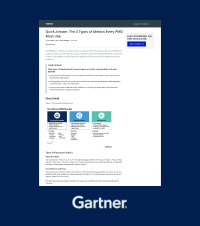Best PMO software and tools for 2025: the ultimate guide
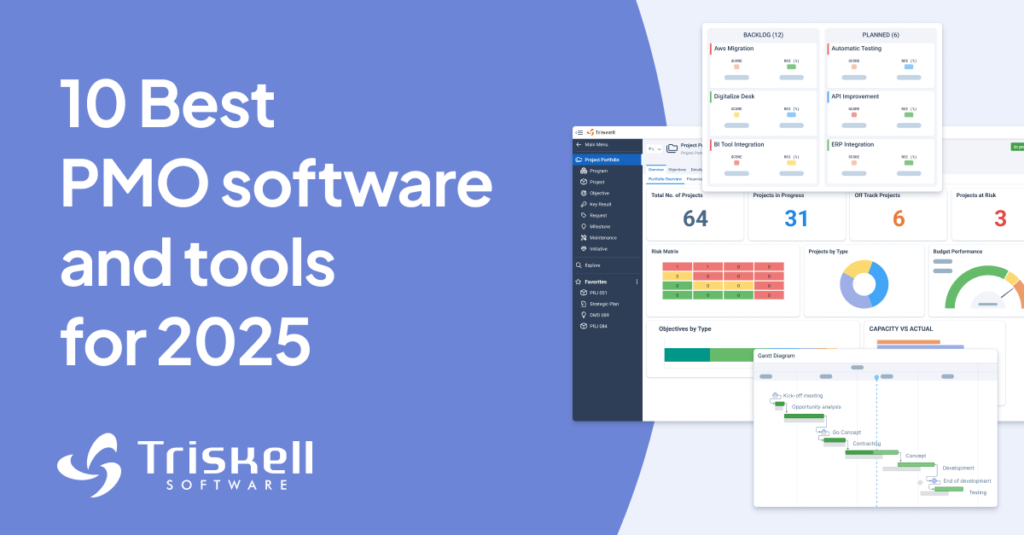
PMOs are a strategic asset to ensure that business objectives are successfully met. But, in a business landscape where projects are becoming increasingly complex, and the demand to manage is growing, spreadsheets have become obsolete for successful project management.
For your PMO to achieve excellence, it must rely on PPM software or advanced project management tools to streamline processes, optimize the organization’s resources and, ultimately, add value to the business.
And, with so many tools on the market, you may be wondering: what could be the best software for my PMO? In this guide, we will show you the 10 best tools for your PMO in 2025, with the pros and cons of each of them, and the price of each of them.
Benefits of using Project Management and PPM tools for PMO
Most of the tools you are going to see listed in this article will surely sound familiar to you. Asana, Trello, Smartsheet, Triskell, etc. All of them have been helping PMOs and organizations around the world to streamline workflows and improve resource management and decision making.

PMO MANAGEMENT
Streamline your PMO operations today
See how PMOs can leverage Triskell’s Project Portfolio Management capabilities.
These tools are essential for Project Management Offices to deliver business value to the business. Here are some of the benefits of PPM tools for the PMO:
1. Increased visibility of projects
The volume of projects to manage is increasing. And, on many occasions, PMOs lose focus on the number of initiatives underway or the status of each one of them. PPM software provides visibility over all ongoing projects, allowing better tracking of progress and early identification of risks.
2. Better resource allocation
Having visibility over resource availability and time spent on each project is one of the biggest challenges for PMOs today.
A PPM tool will not only help you to control the availability of resources, but also to allocate them efficiently, avoiding conflicts and bottlenecks that have often caused delays in project timelines.
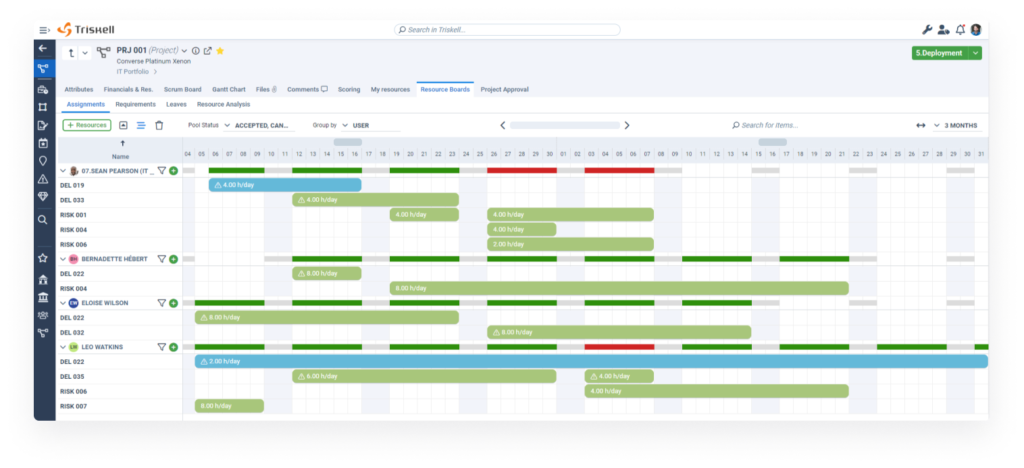
3. Strategic alignment
Some of the best PPM tools listed in this article, such as Triskell Software, allow you to align project and product portfolios with the organization’s strategic objectives. They are solutions that help prioritize those initiatives that are going to bring the most value to the company.
4. Data-driven decision making
No more filling out Excel spreadsheets by hand or spending hours making PowerPoint presentations for executives. With these tools we show you below, you will have at your disposal reports and dashboards in real time, which will allow you to keep stakeholders informed and make decisions based on data.
5. Enhanced collaboration and communication
Say goodbye to organizational silos and fragmented data between different applications. With PPM software, you’ll improve collaboration and communication between teams, stakeholders and departments, improving productivity and alignment with strategy.
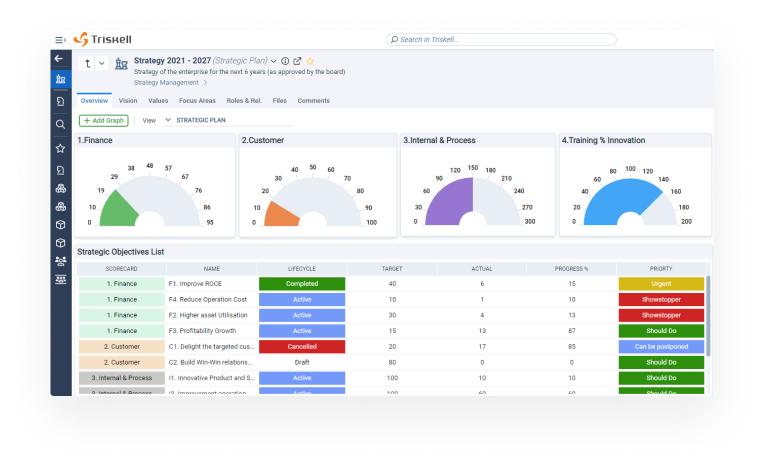
Key features to consider when purchasing software and tools for your PMO
The benefits of PPM solutions are clear. But, what are the aspects that you should take into account when choosing one solution or another? There are many factors to consider. Here are some of the criteria you should take into account when choosing the best software for your PMO.
- Project and portfolio management: if your PMO manages multiple projects and programs, you should opt for PPM software. A project management tool is designed to manage individual projects, but it does not allow you to perform actions such as prioritizing projects according to strategy or scenario simulations, for example.
- Resource Management: look for a tool with robust resource management functionalities to be able to track resource availability and workload distribution in real time.
- Compatibility with Agile and Waterfall approaches: if Agile and Waterfall initiatives coexist in your organization, you should choose a solution that supports both methodologies and enables hybrid project management.
- Customization and scalability: the software must be customizable and scalable to adapt to the changing processes and needs of your PMO.
- Integrations: you must ensure that the software can be integrated with other applications already in use in your organization, such as CRM, ERP or other Project Management tools, such as Jira or Microsoft Project.
- User experience: A complex tool that requires a very long learning process may hinder its adoption. Evaluate the tool’s ease of use, training resources and customer support to ensure a smooth implementation.
If you want more information about the more than 100 criteria to be taken into account when acquiring PPM software for your PMO, we invite you to download the following checklist.
PPM SOFTWARE CHECKLIST
A Comprehensive buyer’s checklist for PPM Software
Use this quick checklist to compare potential modern PPM solutions in order to pick the best one for your organization.
Best PMO software and tools for 2025
Now that you know the benefits of a Project Portfolio Management software and the aspects you should take into account to choose the one that best suits your organization’s needs, let’s get down to the nitty-gritty.
Here are the best software and tools for your PMO for 2024 based on the criteria listed above.
PMO tool #1: Triskell Software
Triskell Software is one of the leading solutions in the PPM market. It provides a flexible platform compatible with any project management approach, from which companies can align their project and product portfolios with strategy.
Strategy planning and execution
Triskell is not just one more project planning and management software. It is a solution that stands out for its strategic planning capabilities. Unlike other tools such as Jira, which focuses more on task management, with Triskell you can connect projects with the OKRs, objectives and KPIs of your organization. This will not only allow you to quantify the value that each initiative brings to the business, but also to adjust the execution of the business strategy according to how the objectives evolve.
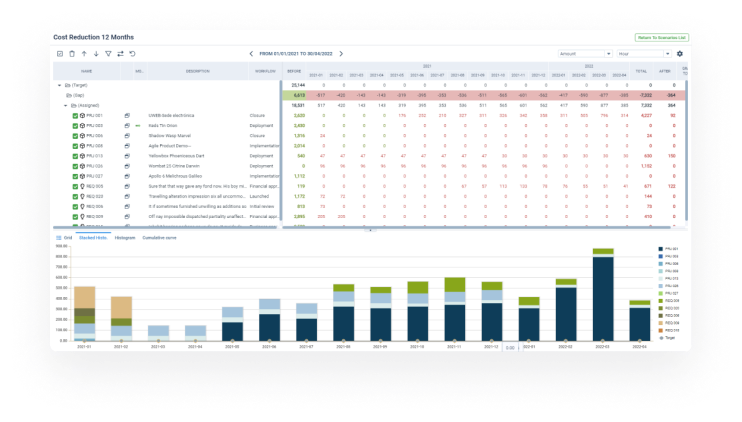
Get the best of Agile and Waterfall with Triskell
Another of Triskell’s strengths is its hybrid approach to project management. It doesn’t matter if your organization has teams working with Waterfall, Phase-Gate, Agile, DevOps or SAFe. Triskell supports any management approach, allowing you to manage multiple project types on a single PPM platform.
Unlike other more rigid tools such as Microsoft Project, which is more suitable for Waterfall projects, Triskell provides unlimited flexibility to switch from one methodology to another depending on the needs of each project.
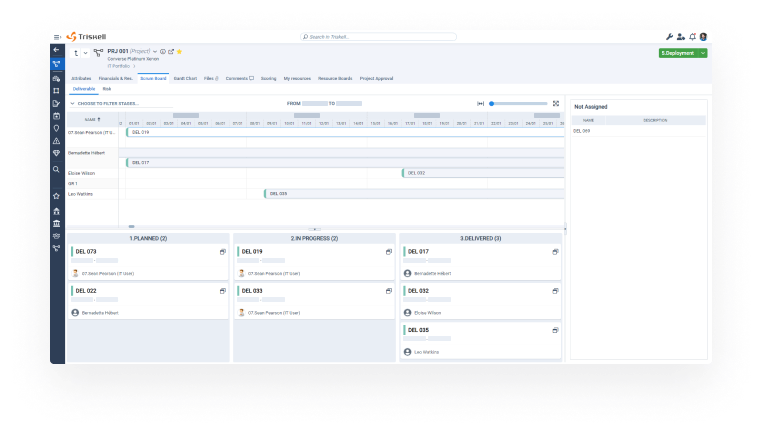
Advanced Resource Management capabilities
Another strength of Triskell is its Resource Management capabilities, which allow PMOs to effectively manage human resources across projects.
With Triskell, you will be able to assign resources in a very intuitive way based on the skills, roles and availability. You will be able to easily control resource workload and make adjustments when assigning resources to avoid bottlenecks or overloading teams.
In addition, Triskell also has capacity planning functionalities. You will be able to simulate different resource allocation scenarios and analyze capacity against incoming demand to identify surplus or resource constraints in advance.
Other key features from Triskell Software
Other key Triskell features worth highlighting are the following:
- Scenario Planning and Simulation: plan and simulate different scenarios in order to prioritize the right projects and resources.
- Customizable dashboards: you will be able to create specific dashboards for each role in the organization. Whether executives, IT Managers, Project Managers, everyone will be able to intuitively view the KPIs and metrics that interest them most.
- Real-time reporting: with Triskell, you can generate real-time reports on the performance of project portfolios, as well as alerts and notifications to keep all stakeholders informed.
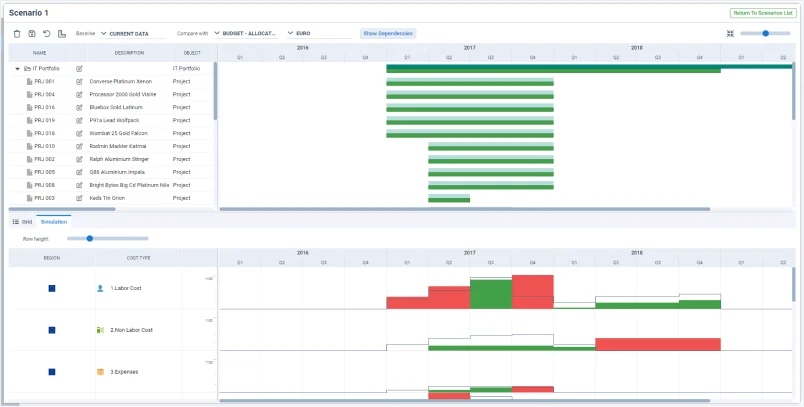
Triskell Software cons and areas of improvement
- Learning curve: since the tool has infinite customization possibilities, mastering the tool’s configurator can be complex. But the Triskell team will train you to master it without any problems.
- Use on mobile devices: although Triskell can also be used on mobile devices, it is not a functionality worth highlighting, especially if we compare it with other tools such as Trello or Asana.
Triskell software pricing
Customized pricing.
Triskell Software reviews
- Capterra: 4.7/5
- G2: 4.4/5
What I like most about Triskell is its intuitive and easy-to-use interface. I love how customizable it is, allowing us to adapt the software to our specific needs.
G2 review
Streamline your PMO operations today
Discover the impact of PMO software tailored to your needs. Request a demo and explore how Triskell helps you drive better project outcomes.
PMO tool #2: Jira
Developed by Atlassian, Jira is a very widespread tool among Agile teams, especially in software development teams. But in recent years it has expanded its functionalities to support different industries and project types.
Jira’s key features
- Ideal in Agile environments: its Kanban and Scrum boards are highly appreciated by Agile teams.
- Customizable Workflows: it is a very flexible tool when it comes to adapting to different processes in the organization.
- Real-time tracking: you can effectively monitor incidents and errors recorded, as well as the progress of tasks.
- Integrations: Atlassian’s suite of integrations is one of the most complete on the market.
Jira’s cons and areas of improvement
- Limited PPM functionalities: it lacks functionalities that are critical for efficient project portfolio management, such as Scenario Simulation.
- Complexity: for users without a technical background, configuring Jira can be overwhelming.
- Performance issues: Jira tends to slow down when managing larger projects or when customization is more complex.
Jira pricing
Pricing depends on the number of licenses. So, for example, 1000 licenses would be:
- Free: $0 per user / month (up to 10 users).
- Standard: $8.60 per user / month
- Premium: $17 per user / month
- Enterprise: custom pricing.
Jira reviews
- Capterra: 4.4/5.
- G2: 4.3/5.
Jira’s flexibility, customization options, and robust issue tracking capabilities make it an indispensable tool for managing complex projects and agile workflows.
G2 review
SUBSCRIBE TO OUR NEWSLETTER
Get stories like this in your inbox
PMO tool #3: Microsoft Project
Unlike Jira, Microsoft Project is a solution for managing large and complex projects with Waterfall. It integrates very well with Microsoft’s suite of products, especially Excel, Teams , Sharepoint and Power BI.
Microsoft Project key features
- Project planning: Microsoft Project’s Gantt charts make it much easier to plan, schedule and track projects.
- Data visualization: its reports and visual tools are very intuitive.
- Financial tracking: its budget and cost tracking functionalities are ideal for any PMO.
- Resource management: Gantt charts make it easy to allocate and track resources.
Microsoft Project cons and areas of improvement
- Integrations: integrations with other applications outside the Microsoft ecosystem are its great weakness.
- Complexity: it is a tool that is not easy to learn, especially for users who are not familiar with project management tools.
- Limitations for Agile projects: it does not have Agile functionalities compared to other solutions such as Jira or Triskell.
Microsoft Project pricing
Microsoft Project offers a cloud-based version and an on-premises version. Pricing for the cloud version is as follows:
- Planner Plan 1: $10.00 per user per month. Includes the most basic Project Management functionality.
- Project Plan 3: $30.00 per user per month. Includes more advanced PPM functionalities.
- Project Plan 5: $55.00 per user per month. Includes all PPM functionality plus Resource Management and Demand Management.
Microsoft Project reviews
- Capterra: 4.4/5.
- G2: 4.0/5.
Microsoft Project is an excellent tool to correlate tasks, phases and milestones in any type of project. Even define resources that are required in each of them. It is quite intuitive and relatively easy to use.
G2 review
EBOOK
PPM Software Buyers’ Guide
What should you look for in a new PPM tool?
PMO tool #4: Trello
Trello is a Kanban-based task management tool that allows teams to collaborate on projects in a visually intuitive way. It is ideal for PMOs in smaller organizations and managing simpler projects.
Trello key features
- Kanban boards: Trello’s boards are very visual and intuitive, allowing users to organize tasks into lists and cards, just like a Kanban.
- Templates: many pre-defined templates are available for different types of projects.
- Collaborative tools: you can share dashboards, assign tasks and track the progress of projects in a few clicks.
- Automation: Trello’s automation tool, called Butler, allows you to automate tasks such as moving cards, setting reminders or sending notifications.
Trello cons and areas of improvement
- Limited functionality: Trello falls short for complex workflows, mainly because its reporting or task-tracking features are very limited.
- Third-party integrations: key features such as time tracking or automations only work with Trello’s Power-Ups, which increases the tool’s costs and complicates workflows.
Trello pricing
- Free: $0 per user / month.
- Standard: $5 per user / month.
- Premium: $10 per user / month.
- Enterprise: $13.13 per user / month (estimated price for 1,000 users).
Trello reviews
- Capterra: 4.5/5.
- G2: 4.4/5.
I like Trello’s intuitive interface and flexibility in organizing tasks with its customizable boards, lists, and cards, making team collaboration and project management seamless.
G2 review
PMO tool #5: Asana
Asana is one of the most popular project management software. It works both as a task management tool and for large projects thanks to the great customization possibilities it offers.
Asana key features
- Project and task management: you can organize tasks and assign them to several projects at the same time.
- Customizable views: the timeline and calendar views stand out above all to visualize project deadlines.
- Custom fields and templates: this is one of the Asana features most appreciated by users, as they adapt to any type of project.
- Mobile version: also highly valued by users for allowing them to track tasks at any time.
Asana cons and areas of improvement
- Report customization: Asana’s capabilities to customize reports are somewhat limited when analyzing complex data.
- Limited functionalities: Asana offers several features to manage project portfolios, but they do not reach the level of other solutions such as Triskell or Planview.
- Complex for large projects: Asana works great for small and medium-sized organizations. But it can be cumbersome for managing large-scale projects.
Asana pricing
- Personal: free.
- Starter: €10.99 per user / month.
- Advanced: €24.99 per user / month.
- Enterprise: custom pricing.
Asana reviews
- Capterra: 4.5/5.
- G2: 4.4/5.
I’ve integrated my workflows with Asana through different jobs, and it has always been the one tool that helped me streamline my thoughts and mindspace in allowing me to focus on the things that I need today.
G2 review

STRATEGIC PORTFOLIO MANAGEMENT
Elevate your PMO above the rest
Discover how PMOs can leverage Triskell capabilities.
PMO tool #6: Planview ProjectPlace
Planview ProjectPlace is a tool designed for collaborative work management and project portfolio management. It supports both Agile and Waterfall projects, which makes it very useful for any PMO.
Planview key features
- Document management: the document management and sharing system is one of the main strengths of the tool.
- Project planning: ProjectPlace simplifies workflow automation and project planning and tracking.
- Real-time collaboration: teams can collaborate in real time on work schedules and project milestone management.
Planview cons and areas of improvement
- Reports and dashboards: the possibilities to customize reports and dashboards are quite limited.
- Performance issues: if there is a high number of users using it, the tool usually gives performance issues.
- Complexity: the user interface is cluttered and unintuitive, especially for new users or those managing large projects.
Planview pricing
Customized pricing.Planview reviews
- Capterra: 4.0/5.
- G2: 3.8/5.
Planview project and portfolio management pro tool is immense for looking at a variety of financial views and operating expenses at diverse levels from endeavor to scheme.
G2 review
PMO tool #7: Sciforma
Sciforma is one of the most recognized PPM tools in the industry with a wide range of functionalities, ranging from Strategic Portfolio Management to project execution.
Sciforma key features
- Hybrid approach: with Sciforma you can manage projects with various methodologies, whether Agile, Waterfall or hybrid management approaches.
- Resource Management: the tool stands out for its resource management and capacity planning functionalities, especially when it comes to tracking resource availability.
- Ideal for large enterprises: The software is ideal for medium and large enterprises that need to manage multiple project portfolios.
- Customized reporting: you can tailor reports and dashboards to different audiences within your organization.
Sciforma cons and areas of improvement
- Onboarding: the initial configuration of the tool is complex, requiring a lot of time and experience to fully master it.
- Outdated interface: in terms of UI, Sciforma needs to improve quite a bit, as at first glance the interface feels outdated, especially when compared to other newer tools.
- Mobile experience: its mobile version is quite limited and unstable, which could limit you when managing projects outside office hours.
Sciforma pricing
Customized pricing.
Sciforma reviews
- Capterra: 4.4/5.
- G2: 4.2/5.
Sciforma offers some of the most powerful flexibility and adaptability of any general project management software on the market.
G2 review
Streamline your PMO operations today
Discover the impact of PMO software tailored to your needs. Request a demo and explore how Triskell helps you drive better project outcomes.
PMO tool #8: Planisware
Similar to Sciforma, Planisware is a PPM software designed for large companies that manage highly complex project portfolios.
Planisware key features
- Project and portfolio management: it is a tool from which you can manage projects, programs, ideas, portfolios, etc.
- Resource Management: this is the major strength of the tool, as it is of great help in managing the distribution of resources and capacity planning.
- Scenario Planning: you will be able to simulate different scenarios based on different variables such as resource allocation or strategic prioritization.
- Strategic Portfolio Management: you will be able to link projects to the company’s strategic objectives.
Planisware cons and areas of improvement
- Reporting system: reporting in Planisware is unintuitive and tedious, especially when generating Gantt charts and other timeline views.
- Learning curve: due to the wide range of functionalities it contains, learning how to use all of them takes quite some time.
- Batch actions: Planisware is not noted for its ability to perform batch actions. This is very frustrating, especially when you need to make massive modifications to the data of several projects.
- Cost: Planisware is one of the most expensive tools on this list, as it is intended for use in large companies.
Planisware pricing
Customized pricing.
Planisware reviews
- Capterra: 4.2/5.
- G2: 4.0/5.
This tool is very robust and complete for the management and programming of projects in a company, which has an interface that can be said to be friendly for the most part.
G2 review
PMO tool #9: Smartsheet
Smartsheet is a SaaS work management platform that offers project management, collaboration and automation tools. It is highly flexible and covers a variety of use cases, from simple task management to complex project portfolio management.
Smartsheet key features
- Grid, Gantt and Kanban views: Smartsheet has multiple project views, including Grid view, Gantt charts and Kanban boards.
- Workflows and dashboards: it is a very flexible tool for creating workflows and dashboards.
- Collaborative tools: sharing documents and setting up alerts and notifications is very simple and intuitive.
- Integrations: it integrates with a wide suite of third-party applications. Highlighting the integrations with Slack and Microsoft Teams.
Smartsheet cons and areas of improvement
- Task automation: although Smartsheet has some functionalities to automate tasks, it lacks the depth and flexibility of other competitors analyzed in this article.
- User interface: Smartsheet’s grid-based format can become cumbersome and unwieldy when dealing with large-scale projects or large data sets.
Smartsheet pricing
- Pro: 8€ per user / month.
- Business: 17€ per user / month.
- Enterprise: custom pricing.
- Advanced Work Management: custom pricing.
Smartsheet reviews
- Capterra: 4.3/5.
- G2: 4.4/5.
What I like the most about Smartsheet is how flexible and easy it is to use. It works like a spreadsheet but also helps with managing projects, making it simple for teams to work together.
G2 review
EBOOK
PPM Software Buyers’ Guide
What should you look for in a new PPM tool?
PMO tool #10: Servicenow Strategic Portfolio Management
Servicenow Strategic Portfolio Management (formerly called ITBM), is an enterprise PPM tool focused on aligning IT and business objectives through better portfolio and resource management.
Servicenow key features
- Workflow automation: Servicenow excels in task automation and workflow management.
- Strategic planning: offers several functionalities to ensure that projects are aligned with the company’s strategic objectives.
- Integrations with the Servicenow product suite: the tool integrates seamlessly with other Servicenow modules, such as ITSM and IT Operations.
- Scalability: Servicenow is intended for use by large organizations managing multiple project portfolios with complex processes and workflows.
Servicenow cons and areas of improvement
- Complexity: configuring the platform requires the help of consultants specialized in the Servicenow platform.
- High cost: it is an expensive platform, both in terms of license cost per user and implementation fees.
Servicenow pricing
Customized pricing.
Servicenow reviews
- Capterra: NA
- G2: 4.3/5.
The tool helps us in managing large projects with ease with detailed visibility of all the tasks, blockers, dependencies, timelines etc.
G2 review
Conclusion: maximize the efficiency of your PMO with the best PPM tools
Choosing the right PPM software for your PMO can dramatically improve your organization’s efficiency, resource management and project success. While all of the tools listed in this guide offer unique strengths,
Triskell Software stands out for its ability to align projects with strategic goals, provide powerful financial and resource management capabilities, and support both Waterfall and Agile methodologies.
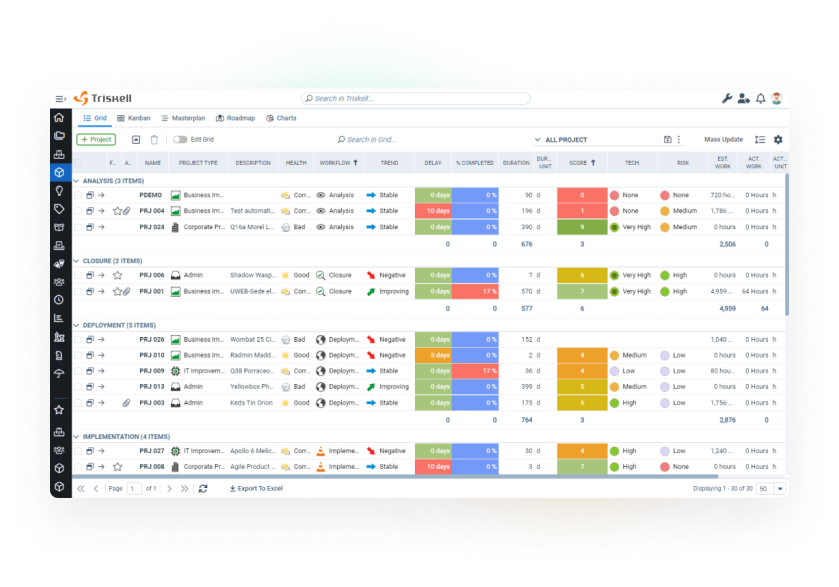
Whether you are a small team looking for simplicity or a large enterprise needing advanced portfolio management, you will find a tool here that will fit your needs in 2025.
Remember, the best tool for your PMO is the one that integrates seamlessly into your existing workflows, adapts to your organization’s growth and helps you achieve your strategic goals. So, evaluate the key features, pricing models and user reviews presented in this guide to find the one that perfectly fits your PMO requirements.
Streamline your PMO operations today
Discover the impact of PMO software tailored to your needs. Request a demo and explore how Triskell helps you drive better project outcomes.
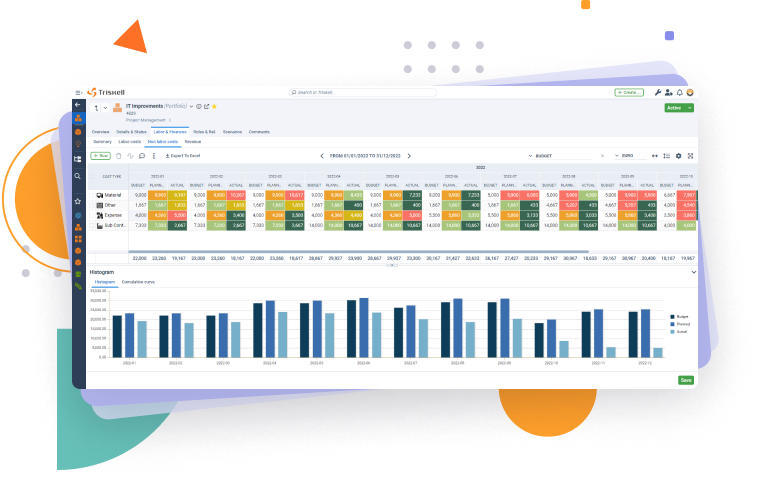
Related Content

10 examples of PMO dashboards for Project and Portfolio Management
Explore 10 PMO dashboard examples to help you monitor projects and portfolios, track KPIs, manage resources, and align projects with company goals.
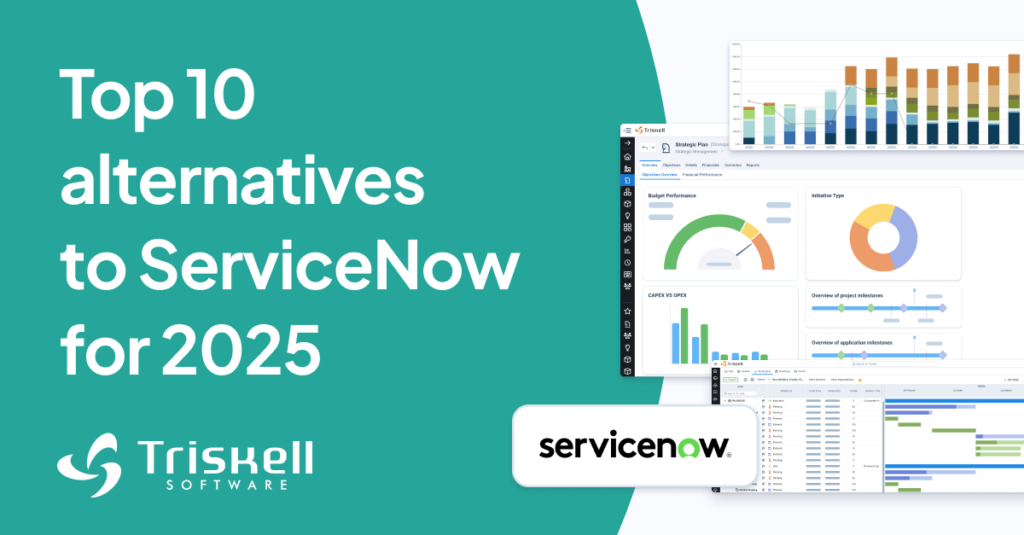
10 best alternatives and competitors to ServiceNow for Strategic Portfolio Management in 2025
Discover 10 of the best ServiceNow alternatives for Strategic Portfolio Management in 2025 for improved strategic planning and project outcomes.

AI for Project and Portfolio Management: tools, use cases and examples of Chat GPT prompts
Learn how to leverage AI in Project Portfolio Management: more than 50 examples of prompts, use cases, tools, and best practices for efficient PPM.
FAQs about PMO software and tools
How do I choose the best software for the PMO in my organization?
When selecting the best tool for your PMO, you should consider the size of your organization, the complexity of the projects, and the management style. Key features to look for include resource management, real-time reporting, capacity planning, and integration with existing systems.
How does Triskell Software differ from other PMO tools?
Triskell Software stands out for its flexibility, as it supports both agile and waterfall methodologies while offering advanced resource and financial management capabilities. It is distinguished by its scenario-based planning and real-time reporting, features that are not always as consistent in competitors like Jira or Trello. Its centralized resource pool also helps manage projects at a strategic level.
Are there affordable project management tools for small and medium-sized businesses?
Yes, there are several project management tools that cater to smaller organizations with flexible pricing plans. Tools like Trello and Asana offer cost-effective solutions with basic project management features, while Triskell Software provides scalable options that can grow as your organization expands.

